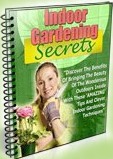Posts Tagged ‘organic gardening’
 Indoor Gardening Supplies For Winter Fun
Indoor Gardening Supplies For Winter Fun
What gardener doesn’t sit inside in the winter with the plant catalogue on
their lap while sipping their tea and dreaming of next year’s garden? Well,
it’s just as much fun to get some indoor gardening supplies and have some
winter gardening fun. One can use it to start seedlings or merely raise
indoor plants, but either way with the right indoor gardening supplies, one
doesn’t have to wait for summer to get one’s fingers dirty again.
Let There Be Light
Probably the most important thing to address in indoor gardening is the
level of light. In the winter, the days are shorter and this means less
light. If your house doesn’t have a suitable window facing south to begin
with to capture the most light, you’ll continually have to supplement the
light quotient by moving plants around to capture more sun. Not the optimal
solution. For winter indoor gardening, appropriate light sources are one of
the essential indoor gardening supplies. Some people rely on fluorescent
lights, and others use halogen lights or high intensity discharge lamps.
Some even try to grow them with incandescent light, but that doesn’t work
too well for all plants.
Either way, one should be aware of the light requirements of the indoor
plants one is trying to grow and pick lighting suitable for them.
Water Or Earth
There are a variety of ways you can grow plants inside, some are based on
nutrient rich water-based systems, and others rely on good old Mother Earth.
The type of garden you choose will determine the indoor gardening supplies
you need. Soil-less systems are called hydroponics and are considered
optimal indoor growing systems. They reduce the damage to crops from weeds
and pests. They are a bit more complex to learn, but can be learned fairly
quickly. Indoor gardening supplies usually have an assortment of hydroponics
kits available to the average consumer.
If you are rooting cuttings or growing seeds to transplant outdoor, then
jiffy peat cups or seedling starter kits are available in indoor gardening
supplies. These allow one to plant seeds indoors with a minimum of mess from
soil. They’re compact, easily transported, and the peat pots can be planted
outside pot and all!
Indoor gardening is a rewarding hobby and many people focus on a particular
type of plant. Some like cactuses, others like tropicals, and still other
people grow herbs indoors. Whatever plant you choose, they will have their
own unique growing requirements and optimal environments. Cactuses,
obviously, would want a very dry, hot environment while herbs love
hydroponic setups. So, while choosing your indoor gardening supplies, keep
in mind what plants you will be growing and try to mimic the environment
they naturally grow in for best results.
 Vegetable Gardening
Vegetable Gardening
Vegetable gardening can be done on almost any scale. For some people, vegetable gardening is simply a large pot with one or two tomato plants in it. Other people might have a larger plot in their yard or some other area, with a variety of plants, to include tall beans or corn as well as tomatoes, lettuce or even potatoes.
When vegetable gardening, the gardener must consider the geographic location of the garden, the kind of soil and the length of the growing season. While many of the same kinds of vegetables can be grown in Alaska that can be grown in Florida, the varieties will not be the same. The vegetables grown in Alaska will be able to adapt to a shorter, cooler growing season than the vegetables that will thrive in Florida’s climate. It is possible to grow a variety of vegetables anywhere, but the gardener must then also consider having some form of hot house or other means by which the climate for the vegetable gardening can be controlled.
For this reason, a new gardener must be cautious when starting vegetable gardening. Many seeds and plants will seem desirable, but if the gardener doesn’t plan, the seeds or plants may not grow and thrive because the weather or soil conditions are not appropriate. If one simply wants some home-grown tomatoes, one can find a large pot and plant some seeds, or some small transplants, for an appropriate tomato. Large tomatoes, such as one might find in a hamburger, are usually not grown successfully in single pots. These tomatoes need room to grow and one plant will need on pot. Most homes don’t have the room inside to have lots of large tomatoes growing indoors. It would be easier to find small tomato plants or a hanging basket that would remain outside on a porch might be more appropriate.
Generally, vegetable gardening is done outdoors. Once a gardener has successfully grown a small plant, and eaten the produce from that plant, the gardener wants to try more, larger plants. If the gardener isn’t careful, too much can be attempted in one growing season and the garden can become more trouble than it is worth or a failure. A gardener who is new to the concept of vegetable gardening should take the time to plan and ask questions of other gardeners in the area. In many cases, a new gardener might want to become friendly with the staff at the local garden center. Someone on the staff will have lots of experience with vegetable gardening and can answer the new gardener’s questions.
